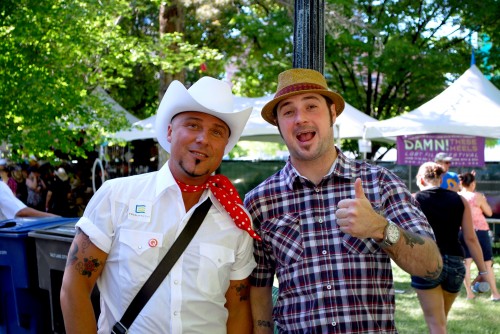by Kylee Hill photos by Adam Vicinus and Mark Salgado
An alternative to hiding in the shadows
“The gay lifestyle.” It’s a popular catchphrase that has been appearing in conservative discourse for years, but is there anything really “alternative” about being gay? If the tens of thousands of people who converged on Salt Lake City for the Utah Pride Festival the first weekend in June were any indication, the LGBT community here is anything but homogeneous.

What started as a small gathering in the ‘80s has grown exponentially in recent years. The 2011 festival spanned three days and included live music, dozens of booths and vendors, and huge parties all over the city. The climactic event – the Pride Parade on Sunday, June 7th – boasted Roseanne Barr as the Grand Marshal, and managed to be so difficult to ignore that it earned small write-ups in both KSL and The Deseret News
Over a hundred different groups marched in this year’s parade, making it just as big as the Days of ‘47 Parade (and at least twice as interesting). Everyone from drag queens to Speedo-clad dancers to the Utah Gay Fathers Association were represented, along with many local politicians and businesses who turned up to show their support for Utah’s queer community.
One particularly ardent parade-goer brought his neon-blue poodle to march with him. A staggering number of gay nightclubs decked out their floats with preternaturally attractive, half-nude 20-somethings. A woman marched as a giant banana while a man dressed in a (frankly, terrifying) ape costume rode a bicycle and held a sign advocating a local politician.
But the most striking as pect of this year’s parade wasn’t the spectacle, although there was no shortage of wigs, glitter, and “Born This Way” renditions. It was the sheer number of average citizens marching in unremarkable attire, holding signs or standing on floats, spreading a message of tolerance. Families of all stripes marched with their children. Young adults from high schools and colleges all around the state came in their school colors. Dozens marched with T-shirts that read “I’m straight and I support equal rights.”
pect of this year’s parade wasn’t the spectacle, although there was no shortage of wigs, glitter, and “Born This Way” renditions. It was the sheer number of average citizens marching in unremarkable attire, holding signs or standing on floats, spreading a message of tolerance. Families of all stripes marched with their children. Young adults from high schools and colleges all around the state came in their school colors. Dozens marched with T-shirts that read “I’m straight and I support equal rights.”
It’s an outpouring of love that was much-needed for many in a state dominated by conservative politics and culture. Garin Lee, a 22-year-old Salt Lake City resident, has been coming to the pride festival since he was 17, before he was even “out” to his family and friends.
“It’s great to come and feel like you’re part of something bigger,” he said. “It’s the best weekend of the year.”
He adds that he plans to adopt children someday and bring them to the celebration.
And if there was anything that united the community of people who attended the festival, it wasn’t a single lifestyle, political message, or sexual orientation. It was the simple act of celebrating love – of all kinds. And there’s nothing alternative about that. §


